Chentao Wu
BAPFL: Exploring Backdoor Attacks Against Prototype-based Federated Learning
Sep 16, 2025Abstract:Prototype-based federated learning (PFL) has emerged as a promising paradigm to address data heterogeneity problems in federated learning, as it leverages mean feature vectors as prototypes to enhance model generalization. However, its robustness against backdoor attacks remains largely unexplored. In this paper, we identify that PFL is inherently resistant to existing backdoor attacks due to its unique prototype learning mechanism and local data heterogeneity. To further explore the security of PFL, we propose BAPFL, the first backdoor attack method specifically designed for PFL frameworks. BAPFL integrates a prototype poisoning strategy with a trigger optimization mechanism. The prototype poisoning strategy manipulates the trajectories of global prototypes to mislead the prototype training of benign clients, pushing their local prototypes of clean samples away from the prototypes of trigger-embedded samples. Meanwhile, the trigger optimization mechanism learns a unique and stealthy trigger for each potential target label, and guides the prototypes of trigger-embedded samples to align closely with the global prototype of the target label. Experimental results across multiple datasets and PFL variants demonstrate that BAPFL achieves a 35\%-75\% improvement in attack success rate compared to traditional backdoor attacks, while preserving main task accuracy. These results highlight the effectiveness, stealthiness, and adaptability of BAPFL in PFL.
STREAMINGGS: Voxel-Based Streaming 3D Gaussian Splatting with Memory Optimization and Architectural Support
Jun 09, 2025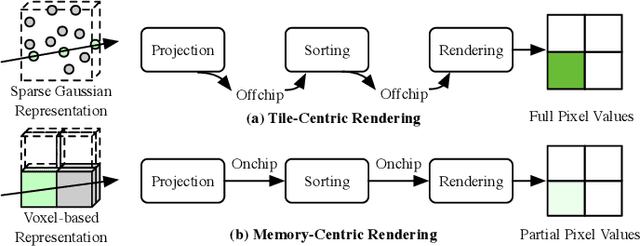



Abstract:3D Gaussian Splatting (3DGS) has gained popularity for its efficiency and sparse Gaussian-based representation. However, 3DGS struggles to meet the real-time requirement of 90 frames per second (FPS) on resource-constrained mobile devices, achieving only 2 to 9 FPS.Existing accelerators focus on compute efficiency but overlook memory efficiency, leading to redundant DRAM traffic. We introduce STREAMINGGS, a fully streaming 3DGS algorithm-architecture co-design that achieves fine-grained pipelining and reduces DRAM traffic by transforming from a tile-centric rendering to a memory-centric rendering. Results show that our design achieves up to 45.7 $\times$ speedup and 62.9 $\times$ energy savings over mobile Ampere GPUs.
LocalGCL: Local-aware Contrastive Learning for Graphs
Feb 27, 2024Abstract:Graph representation learning (GRL) makes considerable progress recently, which encodes graphs with topological structures into low-dimensional embeddings. Meanwhile, the time-consuming and costly process of annotating graph labels manually prompts the growth of self-supervised learning (SSL) techniques. As a dominant approach of SSL, Contrastive learning (CL) learns discriminative representations by differentiating between positive and negative samples. However, when applied to graph data, it overemphasizes global patterns while neglecting local structures. To tackle the above issue, we propose \underline{Local}-aware \underline{G}raph \underline{C}ontrastive \underline{L}earning (\textbf{\methnametrim}), a self-supervised learning framework that supplementarily captures local graph information with masking-based modeling compared with vanilla contrastive learning. Extensive experiments validate the superiority of \methname against state-of-the-art methods, demonstrating its promise as a comprehensive graph representation learner.
SecureCut: Federated Gradient Boosting Decision Trees with Efficient Machine Unlearning
Nov 22, 2023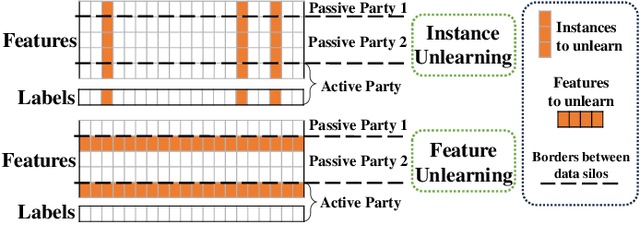


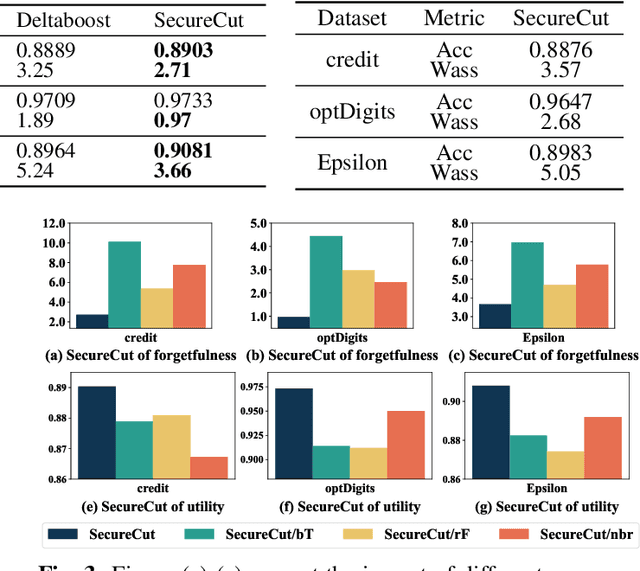
Abstract:In response to legislation mandating companies to honor the \textit{right to be forgotten} by erasing user data, it has become imperative to enable data removal in Vertical Federated Learning (VFL) where multiple parties provide private features for model training. In VFL, data removal, i.e., \textit{machine unlearning}, often requires removing specific features across all samples under privacy guarentee in federated learning. To address this challenge, we propose \methname, a novel Gradient Boosting Decision Tree (GBDT) framework that effectively enables both \textit{instance unlearning} and \textit{feature unlearning} without the need for retraining from scratch. Leveraging a robust GBDT structure, we enable effective data deletion while reducing degradation of model performance. Extensive experimental results on popular datasets demonstrate that our method achieves superior model utility and forgetfulness compared to \textit{state-of-the-art} methods. To our best knowledge, this is the first work that investigates machine unlearning in VFL scenarios.
MARS: Exploiting Multi-Level Parallelism for DNN Workloads on Adaptive Multi-Accelerator Systems
Jul 23, 2023



Abstract:Along with the fast evolution of deep neural networks, the hardware system is also developing rapidly. As a promising solution achieving high scalability and low manufacturing cost, multi-accelerator systems widely exist in data centers, cloud platforms, and SoCs. Thus, a challenging problem arises in multi-accelerator systems: selecting a proper combination of accelerators from available designs and searching for efficient DNN mapping strategies. To this end, we propose MARS, a novel mapping framework that can perform computation-aware accelerator selection, and apply communication-aware sharding strategies to maximize parallelism. Experimental results show that MARS can achieve 32.2% latency reduction on average for typical DNN workloads compared to the baseline, and 59.4% latency reduction on heterogeneous models compared to the corresponding state-of-the-art method.
Temporal Gradient Inversion Attacks with Robust Optimization
Jun 13, 2023



Abstract:Federated Learning (FL) has emerged as a promising approach for collaborative model training without sharing private data. However, privacy concerns regarding information exchanged during FL have received significant research attention. Gradient Inversion Attacks (GIAs) have been proposed to reconstruct the private data retained by local clients from the exchanged gradients. While recovering private data, the data dimensions and the model complexity increase, which thwart data reconstruction by GIAs. Existing methods adopt prior knowledge about private data to overcome those challenges. In this paper, we first observe that GIAs with gradients from a single iteration fail to reconstruct private data due to insufficient dimensions of leaked gradients, complex model architectures, and invalid gradient information. We investigate a Temporal Gradient Inversion Attack with a Robust Optimization framework, called TGIAs-RO, which recovers private data without any prior knowledge by leveraging multiple temporal gradients. To eliminate the negative impacts of outliers, e.g., invalid gradients for collaborative optimization, robust statistics are proposed. Theoretical guarantees on the recovery performance and robustness of TGIAs-RO against invalid gradients are also provided. Extensive empirical results on MNIST, CIFAR10, ImageNet and Reuters 21578 datasets show that the proposed TGIAs-RO with 10 temporal gradients improves reconstruction performance compared to state-of-the-art methods, even for large batch sizes (up to 128), complex models like ResNet18, and large datasets like ImageNet (224*224 pixels). Furthermore, the proposed attack method inspires further exploration of privacy-preserving methods in the context of FL.
Adaptive incentive for cross-silo federated learning: A multi-agent reinforcement learning approach
Feb 15, 2023


Abstract:Cross-silo federated learning (FL) is a typical FL that enables organizations(e.g., financial or medical entities) to train global models on isolated data. Reasonable incentive is key to encouraging organizations to contribute data. However, existing works on incentivizing cross-silo FL lack consideration of the environmental dynamics (e.g., precision of the trained global model and data owned by uncertain clients during the training processes). Moreover, most of them assume that organizations share private information, which is unrealistic. To overcome these limitations, we propose a novel adaptive mechanism for cross-silo FL, towards incentivizing organizations to contribute data to maximize their long-term payoffs in a real dynamic training environment. The mechanism is based on multi-agent reinforcement learning, which learns near-optimal data contribution strategy from the history of potential games without organizations' private information. Experiments demonstrate that our mechanism achieves adaptive incentive and effectively improves the long-term payoffs for organizations.
GraphCoCo: Graph Complementary Contrastive Learning
Mar 24, 2022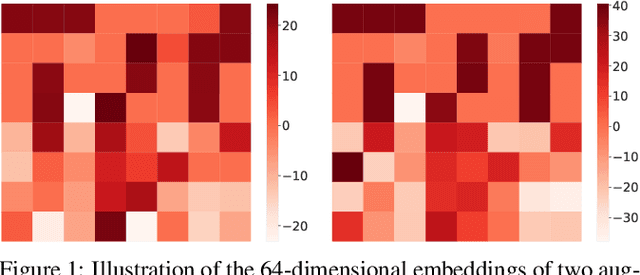


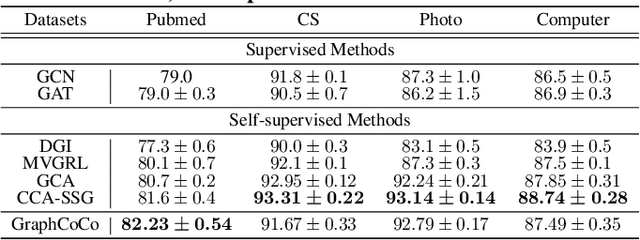
Abstract:Graph Contrastive Learning (GCL) has shown promising performance in graph representation learning (GRL) without the supervision of manual annotations. GCL can generate graph-level embeddings by maximizing the Mutual Information (MI) between different augmented views of the same graph (positive pairs). However, we identify an obstacle that the optimization of InfoNCE loss only concentrates on a few embeddings dimensions, limiting the distinguishability of embeddings in downstream graph classification tasks. This paper proposes an effective graph complementary contrastive learning approach named GraphCoCo to tackle the above issue. Specifically, we set the embedding of the first augmented view as the anchor embedding to localize "highlighted" dimensions (i.e., the dimensions contribute most in similarity measurement). Then remove these dimensions in the embeddings of the second augmented view to discover neglected complementary representations. Therefore, the combination of anchor and complementary embeddings significantly improves the performance in downstream tasks. Comprehensive experiments on various benchmark datasets are conducted to demonstrate the effectiveness of GraphCoCo, and the results show that our model outperforms the state-of-the-art methods. Source code will be made publicly available.
Generative and Discriminative Learning for Distorted Image Restoration
Nov 27, 2020

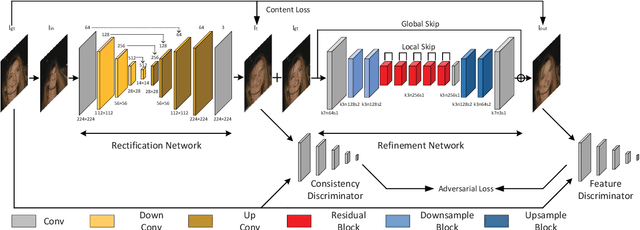
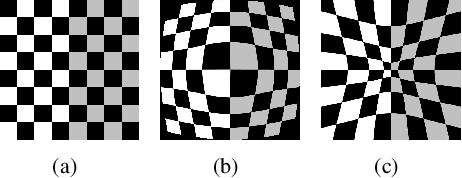
Abstract:Liquify is a common technique for image editing, which can be used for image distortion. Due to the uncertainty in the distortion variation, restoring distorted images caused by liquify filter is a challenging task. To edit images in an efficient way, distorted images are expected to be restored automatically. This paper aims at the distorted image restoration, which is characterized by seeking the appropriate warping and completion of a distorted image. Existing methods focus on the hardware assistance or the geometric principle to solve the specific regular deformation caused by natural phenomena, but they cannot handle the irregularity and uncertainty of artificial distortion in this task. To address this issue, we propose a novel generative and discriminative learning method based on deep neural networks, which can learn various reconstruction mappings and represent complex and high-dimensional data. This method decomposes the task into a rectification stage and a refinement stage. The first stage generative network predicts the mapping from the distorted images to the rectified ones. The second stage generative network then further optimizes the perceptual quality. Since there is no available dataset or benchmark to explore this task, we create a Distorted Face Dataset (DFD) by forward distortion mapping based on CelebA dataset. Extensive experimental evaluation on the proposed benchmark and the application demonstrates that our method is an effective way for distorted image restoration.
Association: Remind Your GAN not to Forget
Nov 27, 2020
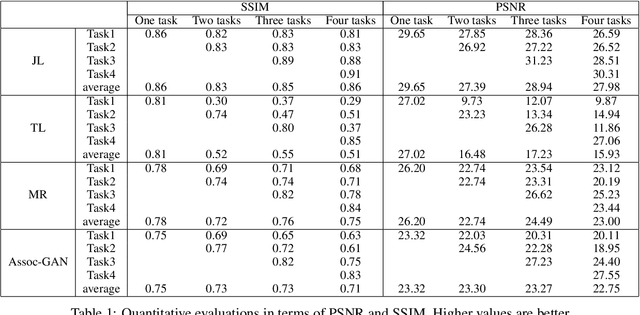
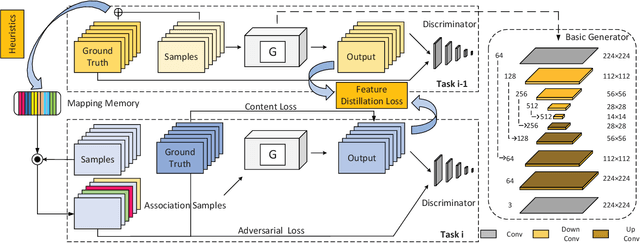

Abstract:Neural networks are susceptible to catastrophic forgetting. They fail to preserve previously acquired knowledge when adapting to new tasks. Inspired by human associative memory system, we propose a brain-like approach that imitates the associative learning process to achieve continual learning. We design a heuristics mechanism to potentiatively stimulates the model, which guides the model to recall the historical episodes based on the current circumstance and obtained association experience. Besides, a distillation measure is added to depressively alter the efficacy of synaptic transmission, which dampens the feature reconstruction learning for new task. The framework is mediated by potentiation and depression stimulation that play opposing roles in directing synaptic and behavioral plasticity. It requires no access to the original data and is more similar to human cognitive process. Experiments demonstrate the effectiveness of our method in alleviating catastrophic forgetting on continual image reconstruction problems.
 Add to Chrome
Add to Chrome Add to Firefox
Add to Firefox Add to Edge
Add to Edge